Last week I initiated a review of decorative masks from Mexico. Briefly, these are masks of artistic design that have the appearance of heavy wear and use, they are said to be associated with ancient traditions, and they reportedly come from isolated but identifiable towns. Unfortunately, most of the documentation that accompanies these masks has been found to be false and invented, while the masks themselves have fantastic and exaggerated designs, and they have been falsely aged. These masks had appeared in great quantities in the latter decades of the 20th century, and became popular in North America due to the influence of one large and beautiful book, Mexican Masks, by Donald Cordry. Cordry had collected hundreds of these masks, thinking that they were not only authentic, but also remarkable, so remarkable that they deserved to appear in books and museums. It seems that few observers were aware of these masks until Cordry’s book appeared in 1980, two years after the author’s death.
For many years I have thought about writing a new version of Cordry’s book, one that praised the best masks, exposed the decoratives, and filled in the gaps. After I began publishing this blog, it occurred to me that I could begin to tackle that project in a series of posts. Last week’s writing on Decorative masks was the introductory installment, and this is the first of three posts that will directly examine the contents of the Mexican Masks book.
Wealthy North American collectors rushed to collect masks like those in Cordry’s book. At the same time, Mexican curators and folk art experts began to study them. Last week I introduced you to three important publications that began to reveal the true nature of these masks:
1. Catálogo de Máscaras del Estado de Guerrero de las Collecciones del Museo Nacional de Antropología, by María Teresa Sepúlveda Herrera, published by the Instituto Nacional de Antropología e Historia in 1982.
2. Changing Faces: Mexican Masks in Transition, by Lori Jacobson and Donald E. Fritz , published by the McAllen International Museum, in 1985, and
3. “Mask Making in Guerrero”, an essay by Ruth Lechuga, in Behind the Mask in Mexico, edited by Janet Brody Esser, and published by the Museum of International Folk Art in 1988.
As you can see, by looking at the dates of these books, there was a progressive accumulation of knowledge. By 1988, the situation had become clear—these masks were false. However, they were not all false. Intermixed in Cordry’s book with this admittedly large group of decorative masks were others that were accurately identified, genuinely worn, rare, and truly wonderful. How could this be?
As a young, healthy investigator and artist, and with the active support of his wife, Dorothy, Donald Cordry was a pioneer in the investigation and collection of Mexican folk art. This couple traveled on horseback and on foot into isolated mountainous areas, and they documented what they discovered with photographs. They were particularly interested in masks and weavings, and supplied these things to museums, such as the Museum of the American Indian, in New York City. Subsequently Donald established a workshop in Cuernavaca, where he directed artisans who produced Mexican crafts.
Based on their research, Donald and Dorothy Cordry wrote a book about Mexican Textiles—Mexican Indian Costumes, which is considered a landmark book in this area, and for which they were awarded the Fray Bernardino de Sahagún Award in 1968 by the Mexican National Institute of Anthropology and History. For this work, the Cordrys were highly respected.
In his middle years, Donald Cordry’s health went into a severe decline. He had one or a series of strokes, he grew weak, and he was no longer able to travel. He had to settle for studying objects of folk art that came to him. Some unscrupulous individuals, let’s call them “operators”, took advantage of this situation. Having commissioned the production of false masks, they developed false aging techniques, invented histories for these masks based on real or invented dances and towns, and offered these masks to Donald Cordry, as if they were rare treasures. In his forced isolation due to ill health, Cordry was apparently grateful for this flow of material.
The polite term for these false masks is “decorative,” while the impolite word is “fake.” Decorative is the English translation for the adjective that the carvers in Guerrero used to refer to such non-traditional masks that they carved “for decoration”—decorativa (see Lechuga page 229, in Esser 1988). Ruth Lechuga also called these “fantasy masks.”
So here we are. We have a book—Mexican Masks—that has so much to teach us, because it is filled with excellent examples of the real and the false. It would be more accurate to say that it is filled with the real, the false and the ambiguous. My task is to help you to identify the masks in these categories. Actually, I have already started to do so, by pointing out the sort of stylistic clues that will help you to identify the masks of a particular carver, and by illustrating the concept of “differential staining” that occurs from authentic use. Fortunately, we do not have to do this alone, as we have the assistance of the authors of the three books that I just listed, along with additional advice from one of the great Mexican experts, Jaled Muyaes, of Mexico City. On February 26, 2005, Jaled, his daughter Karima, and I had gone through Cordry’s mask book together, noting our opinions of each mask.
It may seem excessively tedious for me to direct our attention to nearly every mask in Cordry’s book, but as the saying goes, “Somebody’s got to do it,” even if 34 years have passed since the book was published. I will emphasize the best masks and photographs, and select a representative sample of the decoratives, enough to permit you to see the pattern. The photograph part is easy—every dance photo in Cordry is valuable, reflecting the fact that Donald Cordry took many of these photos during actual fieldwork, at a time in his life when he was strong and vigorous (1935- 1942), while others were taken by reliable authorities such as Ruth Lechuga. The Cordrys seem to have managed a few brief trips back into rural Mexico, for more photos, in the early 1970s, documenting dances and carvers. All of the photos of carvers that were taken by Cordry are also of great interest. According to Jaled Muyaes, the photo of José Rodriguez (page 105) should be regarded as an example of the false evidence that was supplied to Cordry by the “operators.”
Plate 7 (on page 6) is a great example of a valuable photo, along with another from the same place and date, plate 307 (page 247). Taken in Cherán, Michoacán, in 1935, these views of la Danza de la Pastorela (the Shepherd’s Play) reveal a terrific mask of a Hermitaño, and two views of a pair of Diablos, one with a human face and the other with the face of a bull. In 1995, I purchased a beautiful old Diablo from Spencer Throckmorton, which was found near Lake Patzquaro, Michoacán. It had four holes around the forehead, each 3/8” in diameter; I wondered about the purpose of the holes. Then I realized that this mask was by the same hand as the human faced devil in Cordry, but that the latter had four thin snakes attached to the forehead. Thus my question was answered.
Here is the Diablo mask from Lake Patzquaro, Michoacán.
The side view of the mask from Lake Patzquaro. You may wonder how I concluded that this mask and the one in Cordy (plate 7, page 6) were by the same carver. I based this on stylistic details of the carving. Note how each face is divided by recessed curving lines that are painted in a contrasting color to the black face, and how these lines create bulging facial features. For example, look at the left cheek of my mask in this photo. Also the eyes appear to be identical, and both masks have the same carved wooden fangs. Each mask has four holes across the forehead—apparently for the attachment of snakes. On the other hand, it is obvious that my mask is not the same one that is in Cordry’s photo, because those recessed lines do not fall into the same pattern; probably every Diablo by this carver was unique.
The back demonstrates differential staining. Also note that masks from Michoacán commonly show small chisel marks on the back, as in this case. The lateral attachments (horns or snakes?) were evidently broken or sawn off, leaving plugged holes in the back, particularly visible on the right side. In contrast, the horns or snakes in the two center holes have fallen out, leaving tapering holes.
I will provide a brief synopsis of the Shepherds’ Play, La Pastorela. An Angel appears to Shepherds in their fields, telling them of the birth of Christ, in a stable in Bethlehem. The Angel urges the Shepherds to go and pay homage, which they agree to do. The Shepherds enlist a holy hermit, el Hermitaño, to accompany them. As they travel, the Shepherds are approached by a band of Diablos—who are named for and promote “the seven deadly sins,” such as lust, gluttony, … The Diablos attempt to dissuade the Shepherds from continuing their quest, offering them the riches of the world, if they will only turn back. Some of the Shepherds, such as Bartolo, are susceptible to such offers, and waver in their resolve. The Hermit must exhort them to continue, and there may also be further visits by angels to clear the path of the obstructing Devils. The play ends with the sequence familiar to many North American Christians, as the Hermit and the Shepherds file down the aisle of a church and approach the creche.
In 1991, Luis Valdez directed El Teatro Compesino in a film performance of La Pastorela: The Shepherd’s play, for the PBS Great Performances™ series. The Campesino Theatre had been staging live performances of this play at the Mission San Juan Bautista, in San Juan Bautista California, since 1975. After seeing the PBS performance, I sought out a VHS copy, which I have watched repeatedly over the years. Now I am delighted to discover that this performance has been re-released on a DVD. Although the film version contains additions to the original plot that sometimes seem silly and unnecessary, I continue to appreciate it as a Wagnerian musical drama. The Shepherds, guided by El Hermitaño, hike through a rural setting while they sing Mexican Christmas carols. In the role of Luzbel (Lucifer, the most beautiful of all the angels), Robert Beltrán sings a beautiful aria about pride and power, as he attempts to intimidate the Shepherds into turning back from their quest. San Miguel Archangel, played by Linda Ronstadt, overpowers Lucifer in combat, he becomes physically disfigured in his defeat, and he is driven into the fiery pit of Hell. I highly recommend this DVD, as a beautiful introduction to the Pastorela tradition.
Now I will discuss a second valuable dance photo—”Masked Stilt Dancers” from Santa María Roalo, a village near Zaachila, Oaxaca; this dance was photographed by Donald Cordry in 1941 (Plate 137, page 97). In an accompanying illustration, on the same page (Plate 136), Cordry points out that stilt dancing is illustrated in a Codex drawing of a pre-conquest Mexican Indian rite. You can see such dancers, still dancing in Zaachila, on youtube™
— http://www.youtube.com/watch?v=OOjh5NfqzCo.
In the Cordry photo, the dancers are wearing masks that appear to be have been made from molded cloth. These masks resemble those worn by the Jardinero dancers in San Bartolo Coyotepec, Oaxaca, which are made of molded cloth and then dipped in wax. Until I took another look during the preparation of this post, I never realized that the stilt dancers are probably not Jardineros. At any rate, the present day stilt dancers no longer wear masks, although the ones at Zaachila wrap their faces with cloth as if they were preparing to wear a mask. Cordry’s photo provides information that may not be available otherwise, that this was once a dance with masks.
I want to mention just one more dance photo in Cordry—plate 281 (page 230)—that shows Moro characters from the Moors and Christians dance. In the state of Guerrero, it is not uncommon to find masks, such as those worn by Moors and Christians, that are larger than their counterparts in other regions. For this reason one reads sometimes about “big-headed Moors” from Guerrero. There is such a mask in this photo, and wearing a headdress that is equally oversized and notable. Ironically, this photo shares the page with a pair of alleged Moor masks that are wonderfully carved, but fitted with strange painted leather caps. Presented in this way, with these invented caps, such masks must be called decorative.
Now I would like to direct our attention to some special photographs of carvers in Cordry’s book. I will start with the portrait of Don Placido (Plate 140, page 101), who is shown in the act of carving a Pascola mask. I had long suspected that this might be Placido Alamea, one of the great Mayo master carvers of the mid 20th century, and in 2006, Leonardo Valdez, a knowledgeable man who has a Mayo museum in Etchojoa, Sonora, confirmed this for me. Here is a classic Pascola mask by Placido.
Mayo Pascola mask by Placido Alamea. The white chevron designs flanking the nose are typical of this carver.
From the side, we see Placido’s typical rim design and his typical nose, rising delicately to the forehead. The cheeks of this mask are convex, with a mild v-shaped elevation, that is not so easy to see in this photo. Apart from Placido’s son, Marcelo Alamea, few other carvers create convex cheeks. The combination of this rim design and the convex cheeks is strong evidence for this carver, or perhaps his son.
The cross on the chin of this mask by Placido Alamea. There is a similar cross on the forehead.
The back of this mask by Placido Alamea. The numbers on the back suggest that this mask was once in the collection of Jaled Muyaes and Estela Ogazon. They applied such numbers to organize their masks for a show (see next mask). I bought this mask from a dealer in Phoenix, Arizona.
On the same page, Plate 142, a boy sits next to a group of masks that were made by his father, Eliseo García, of Huitziltepec, Guerrero.These would seem to be new, made for sale masks, but they appear to be authentic in style. Ironically, Cordry’s comment about this photo is to point out, with apparent disappointment, that the”spirit helper is missing from the Vulture mask.” That is, having accepted the overdone and decorative version of a particular mask, Cordry perceived the genuine article as inferior. I will get to masks with spirit helper images later in this post. Here I will include photos of a similar bird mask that I obtained from Jaled Muyaes, in 1997.
This “Carnaval Crow” is from Guerrero. Formerly in the collection of Jaled Muyaes and Estela Ogazon, it is actually visible in a photo of their Mexican mask show in Mexico City, in 1981, in Mascaras, Danzas Y Fiestas de Michoacan, (by Nestór García Canclini and Amparo Sevilla Villalobos 1985, page 71). In general, many of the Pastorela Diablos from Michoacan and Guanajuato have relief carved snakes over or around their eyes, so I wonder if this isn’t really a Diablo.
The back of the crow mask. The number on the back, 326, is a clue that this mask had appeared in the 1981 show. This back demonstrates extreme wear, along with damage and old repairs. Note the string binding split edges, to the right of the numbers.
On Page 103 there are photos of Nalberto Abrahán and his son, Ruperto Abrahán. Although the masks in Nalberto’s photo do not seem impressive at first glance, Ruth Lechuga reported in Esser (1988) that Nalberto was the carver of the set of authentic masks for the Manueles Dance that Cordry included on Plate 305 (page 246). Looking back at the photo of Nalberto, I noticed that there is a mask of the Novio from the Manueles dance in the foreground. With this information, I was able to identify an old Manueles mask that had been converted to a Diablo, by the addition of applied horns, as a converted Novio that was the work of Nalberto Abrahán.
This is the Novio mask from the Manueles Dance that I am attributing to Nalberto Abrahán, on the basis of Cordy’s presentation of a group of Manueles masks (on page 246), Ruth Lechuga’s report that those masks were the work of Nalberto, and a nearly identical Novio mask on the ground in front of Nalberto. But I don’t know who added the horns, to convert this to a Diablo. I call your attention to a design feature that is difficult to see in this photo, but clear enough when I look at the actual mask—there are three red lines above the bridge of the nose. One sees the same lines on at least three of the masks in Cordry’s photo—3o5c (the Mother of the Jilted Girl), 305f (the Novio), and 305g (the Novia). These lines are apparently a marker for the work of Nalberto.
The Novio mask that I have attributed to Nalberto. Note the applied wooden horns, converting the mask to a Diablo, a character that does not occur in the Manueles Dance, but in other local dances. Such a handsome devil must be Luzbel (Lucifer), said to have been the most beautiful of all the angels before his fall from grace. The paint on the face is old and cracked, while the paint on the horns is not, as they were added later, and are not as old.
The back of the Nalberto mask. Dust obscures the staining from use.
I have made my case for the value of the photographs in Cordry’s book. Next week I will provide a list of the masks that are excellent and authentic.

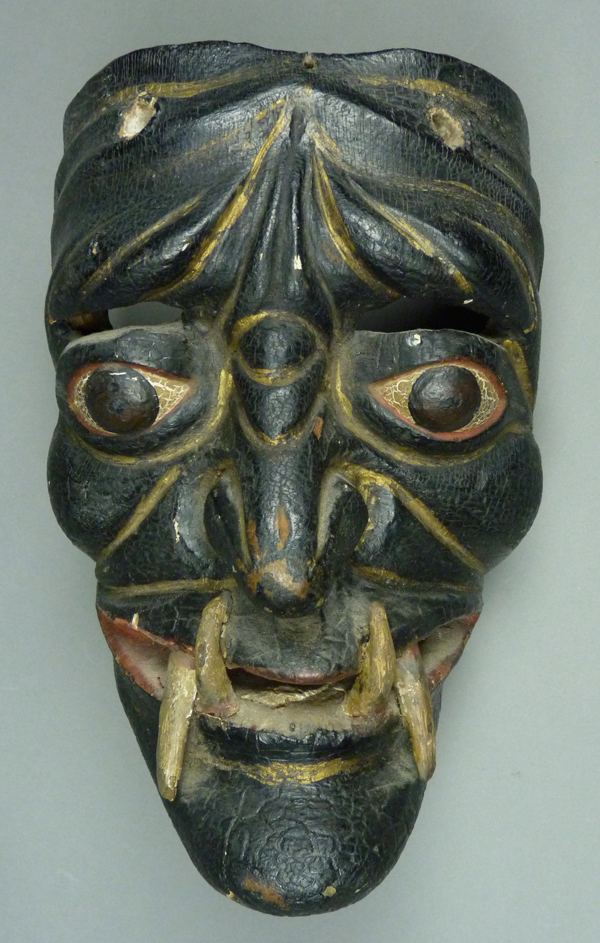

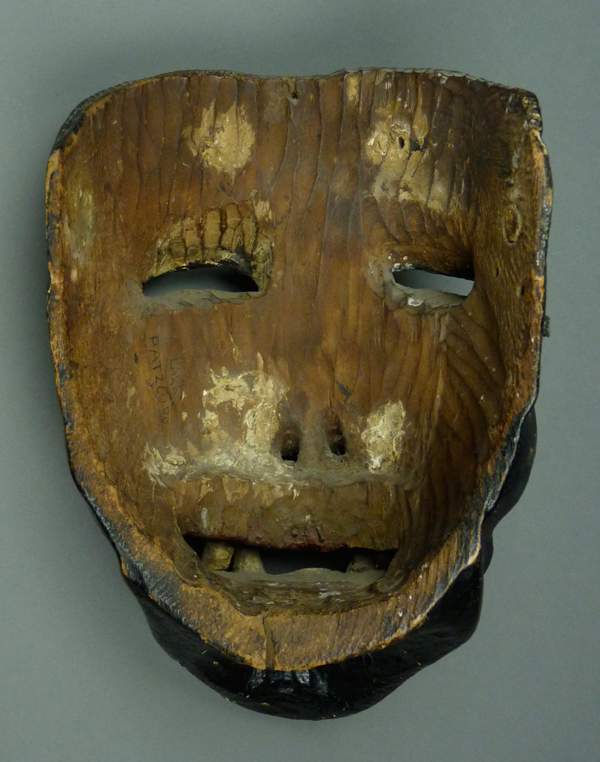


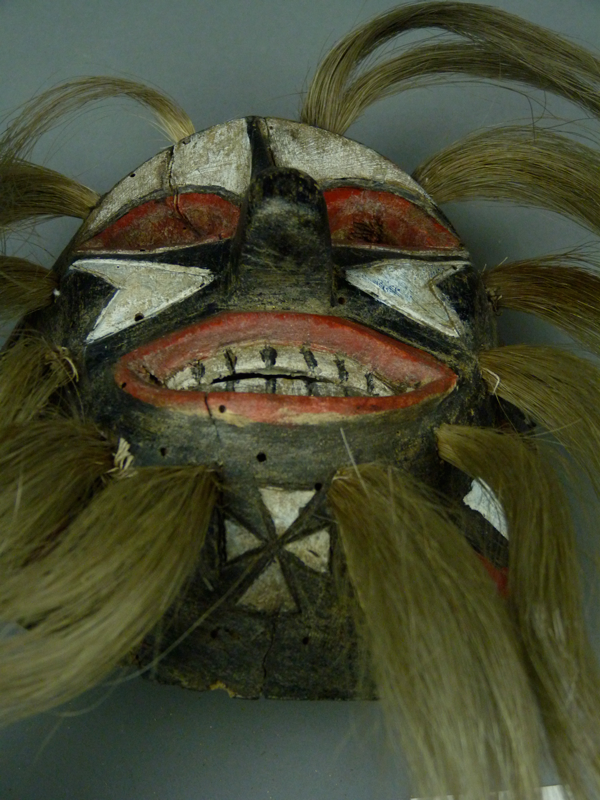
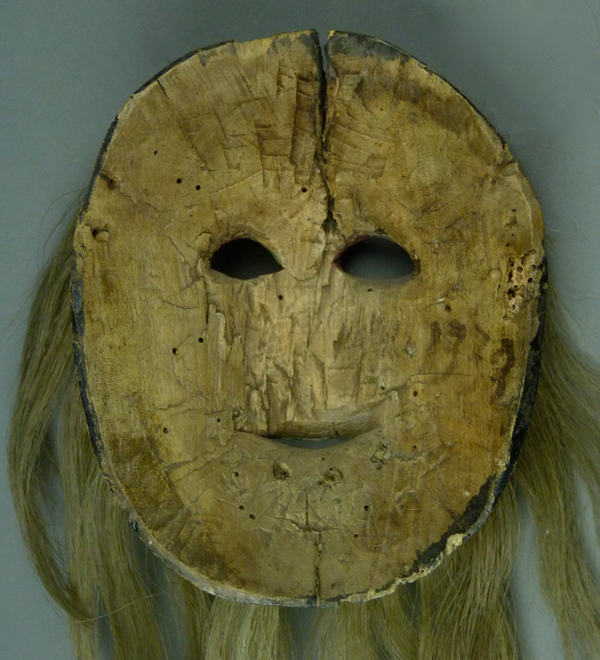
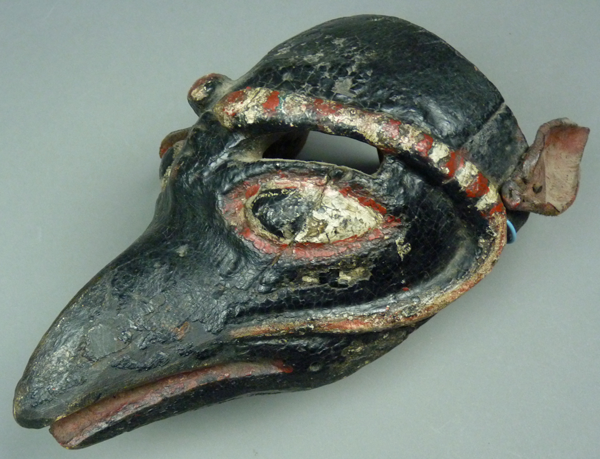
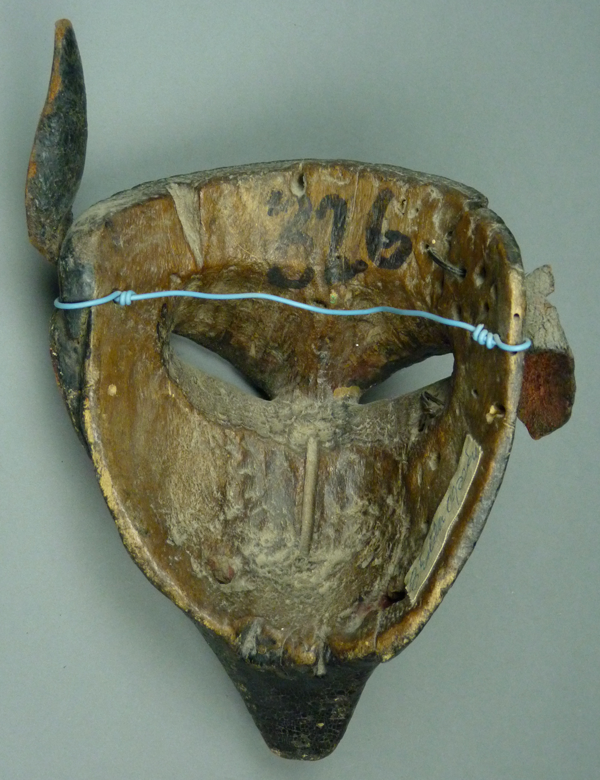
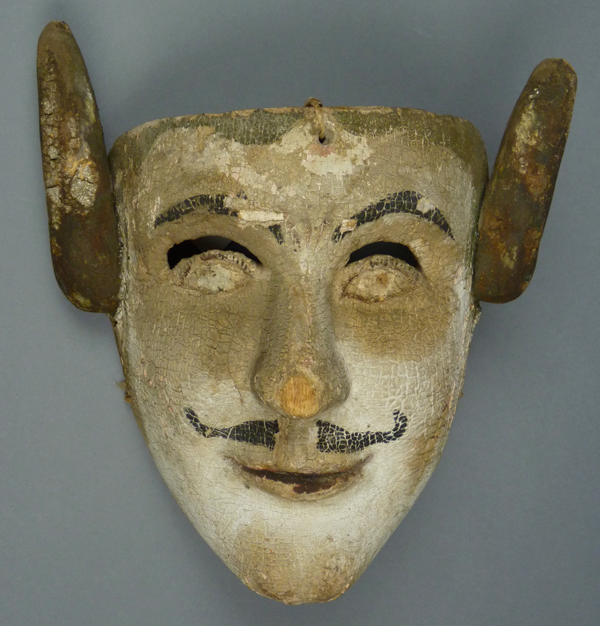
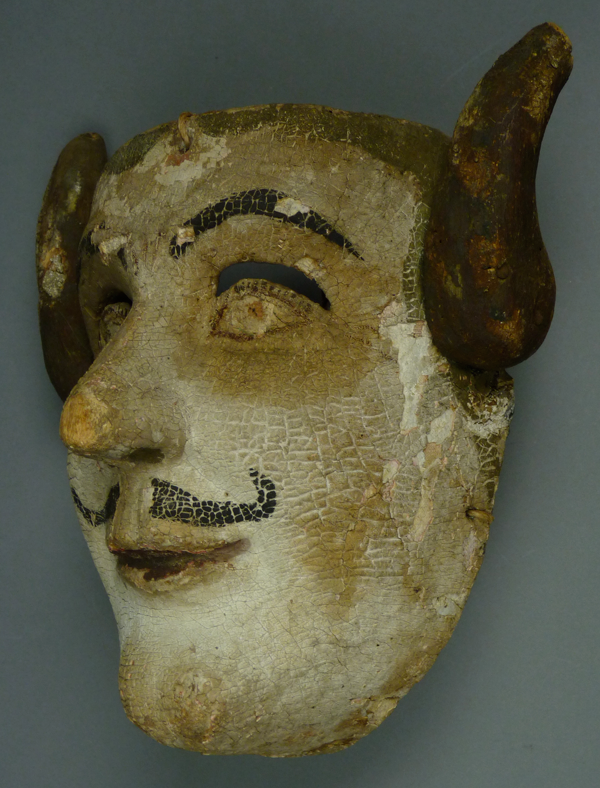

4 comments on “Mexican Masks—An Important Book By Donald Cordry”